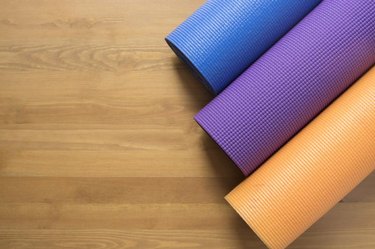
When you've graduated from using a studio-supplied yoga mat to buying your own, it requires a little research. You thought you were just going to grab one off the shelf, but now you have to take into account what material it's made from and if its texture feels right to your hands, feet and even your forehead. Another factor to consider is mat thickness.
Yoga mats range from the super-thin travel variety that roll up tightly to take up little room in your suitcase to plush versions that cushion you during a soothing restorative practice.
Video of the Day
Video of the Day
Which one is right for you depends on the type of yoga you plan to practice. Your joint health and comfort level with balancing postures are other factors to consider.
Thickness Options
Yoga mats range from a skinny 1/16-inch to a plush 1/4-inch. A standard mat is about 1/8-inch thick.
You'll have the most choices in thickness if you select a mat made from PVC, or vinyl. Natural materials, such as bamboo and jute, usually have fewer options.
Read More: What Makes a Good Yoga Mat?
Practice Style
A standard 1/8-inch mat is perfect for pretty much any practice, from a gentle Hatha class to a flowing vinyasa style. Thicker mats are usually best for restorative and Yin classes in which you spend most of the class lying down or seated; your back and head will appreciate the extra cushioning.
If your practice varies from day to day -- Mondays you go to a strong Power Flow, and Wednesdays, you bliss out in restorative -- a standard 1/8-inch mat is the best option to cover all your needs.
If you prefer feeling connected to the floor, as in a practice that includes lots of standing and balancing poses, you might opt for a skinnier mat. Also, if you tend to practice on the go and need to bring your mat with you, a thin 1/16-inch version may be most convenient.

Body Tolerance
Your joint health and tolerance for feeling the floor with bony parts also determines the mat you choose. If your practice often has you kneel in Camel, drop your knees during Chaturanga, hold Forearm Plank or visit repetitive Kneeling Crescent Lunges, you might enjoy a slightly thicker mat to support your sensitive areas. Don't forget that your tailbone might also enjoy a little more cushioning in poses such as Boat.
While these discomforts can be avoided by folding your mat for those particular poses, if coming to your knees or forearms is part of a regular flow, it's not convenient to keep rearranging.
Heaviness
Even if you're not trying to squeeze your mat into a suitcase, carrying a hefty, thick mat to and from the studio can get old fast. If you do choose a thicker 1/4-inch model, note that they can weigh up to 7 pounds, making their transportation a workout in itself.
Read More: PVC Yoga Mat Safety